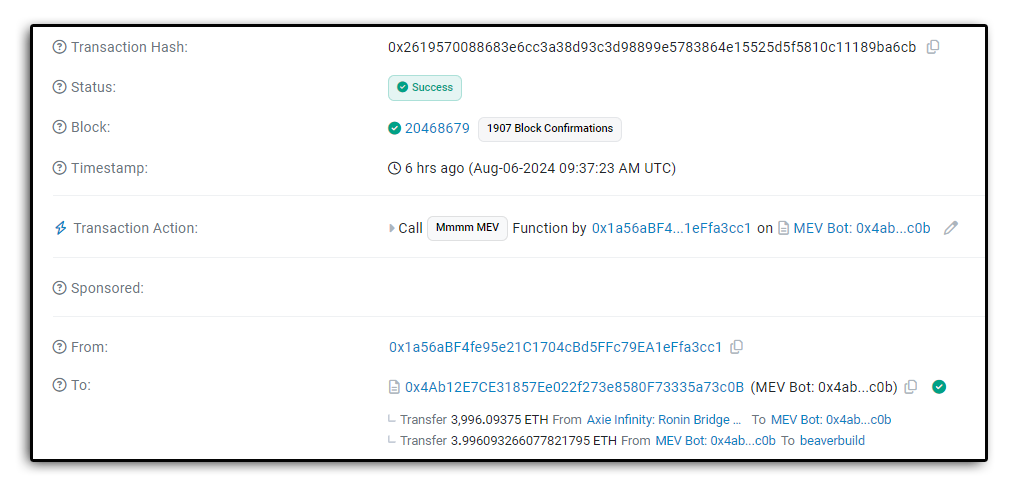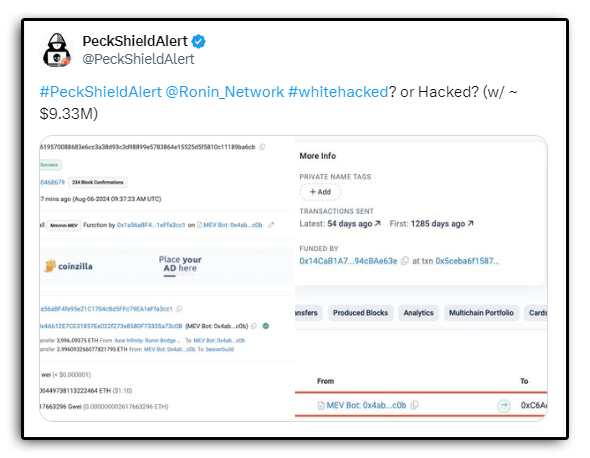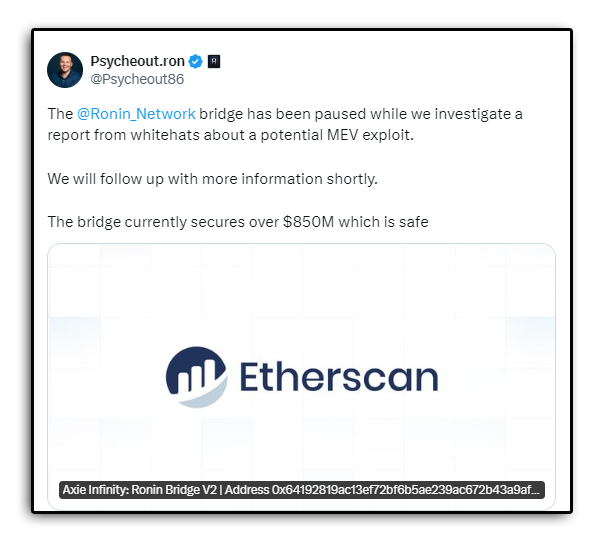As we venture deeper into the year 2024, the cryptocurrency ecosystem finds itself navigating through exceptionally challenging waters. The landscape has been marred by a global market downturn, significantly impacting digital currencies across the board. Moreover, a worrying trend of crypto hacks has emerged, posing serious threats to the security and stability of blockchain networks and their participants. Among these unfortunate events, the Ronin Bridge exploit stands out as a glaring example, with the platform losing a substantial sum of approximately $12 million in cryptocurrency. This incident is a stark reminder of the persistent security vulnerabilities plaguing the blockchain domain.
Details of Lost Funds
In a particularly disheartening event for the Ronin Network – a blockchain network esteemed for its affiliation with gaming – the hack resulted in the loss of 3,996 Ethereum tokens. Additionally, the culprits absconded with 1,998,046.875 USDC. The stolen assets were later manipulated, with a part being converted to 796.411 ETH, equivalent to $2,004,520, through Uniswap. A small fraction of these stolen assets, precisely 3.996 ETH, found its way to BeaverBuild, further complicating the aftermath of this exploit.

Real Hack or Help?
The possibility that this may have been the handiwork of a white hat hacker has been floated by PeckShield, a blockchain security outfit. These ethical hackers, known for their role in uncovering security loopholes to fortify systems rather than exploit them, sometimes return the stolen funds after proving their point. If this turns out to be true, the Ronin Network may well witness the reclamation of its lost assets, contingent on a thorough resolution of the identified security weaknesses.

The Role of MEV Bots
The incident also shines a spotlight on a Maximal Extractable Value (MEV) bot known as “0x4ab,” which seems to have played a part in the exploit. These bots, tasked with identifying arbitrage opportunities within the Decentralized Finance (DeFi) ecosystem, can sometimes inadvertently become tools of exploitation. Such was the scenario with the Ronin Network exploit, according to industry specialists.
Rising Crypto Hacks in 2024
The frequency and severity of cryptocurrency hacks have surged noticeably this year. A staggering $542.7 million was siphoned off in the initial quarter of 2024, marking a 42% uptick from the previous year’s corresponding timeframe. July was particularly grim, witnessing 16 different attacks on DeFi platforms, bridges, and exchanges. Collectively, these incidents resulted in losses exceeding $266 million in crypto assets. The most sizable breach targeted WazirX, an Indian crypto exchange, from which an astonishing $230 million was stolen. Subsequently, the perpetrators amalgamated $57 million worth of ETH into new wallets, likely in preparation to liquidate their ill-gotten gains.
Ronin’s Response and Future Steps
In the wake of this considerable exploit, the Ronin Network took immediate measures by halting all activities on its bridge to stave off further damages. The platform’s COO, Aleksander Larsen, made a statement on X, assuring the community that the bridge’s assets, valued over $850M, were secure for the time being. This pause, as stated, was to facilitate an investigation prompted by a warning from white hat hackers concerning a possible MEV-related exploit.

In a turn of events that can be perceived as a sliver of hope amidst the gloom, Ronin Network announced the recovery of the stolen ETH, valued at nearly $10 million. The platform remains optimistic about the retrieval of the stolen USDC later. The white hats involved in flagging the security flaw were lauded for their efforts with a $500K reward, courtesy of the Bug Bounty Program. This incident not only underscores the critical role of ethical hackers in the digital asset ecosystem but also catalyzes urgent discussions around security protocols.

Future Plans and Audits
In anticipation of resuming operations, the Ronin bridge is slated for a comprehensive audit. The Ronin Network harbors intentions to revamp the bridge’s operational framework, distancing from the existing setup. Collaborations with Ronin validators are in the pipeline, aiming to integrate a novel solution to preempt future security lapses. The collaborative spirit observed within the Ronin community and its allies during these trying times is indicative of a resilient and forward-looking ethos.
The Need for Enhanced Security
The events surrounding Ronin Network’s recent exploit serve as a critical reminder about the persistent need for heightened security measures within the realm of cryptocurrency. With hacks becoming increasingly common in 2024, platforms are urged to elevate their security protocols to safeguard against such vulnerabilities. In this context, ethical hackers emerge as invaluable allies, their expertise instrumental in identifying and rectifying potential security flaws before they can be exploited by malicious entities.
Conclusion
The unfolding scenario of the Ronin Network’s exploit, subsequent interventions, and the broader specter of crypto hacks in 2024 deliver a composite narrative rich with lessons, warnings, and insights. At its core, the dialogue converges on the indispensable value of robust security frameworks in an era where digital assets are both burgeoning in popularity and becoming prime targets for sophisticated cybercriminals. For enthusiasts and stakeholders within the crypto realm, the path forward is paved with the imperative to innovate, secure, and prepare. For more captivating tales and updates from the world of decentralized finance, do check out DeFi Daily News.



















